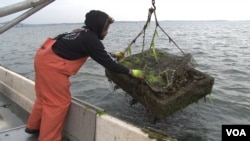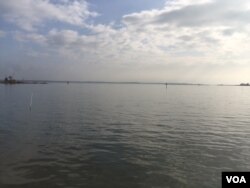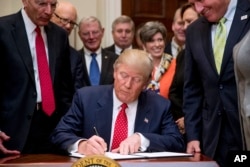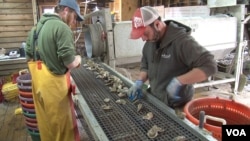Just after sunrise, the crew from the Rappahannock Oyster Company heads out on the river to pull the first oyster cages of the day. Ean Reed navigates the small skiff by sight and memory, watching for rough patches in the water.
The crew will pull nine cages full of two-year-old oysters bound for restaurants across the country. The Rappahannock Oyster Company was started in 2001 by Ryan Croxton whose grandfather, decades earlier, fished oysters from the muddy Rappahannock River bottom near the Chesapeake Bay.
As the boat enters shallow water, Reed raises the outboard motor while pointing out local landmarks such as the 3-kilometer Norris Bridge connecting Virginia's Lancaster and Middlesex counties. He starts pulling up the almost-meter-square cages, which look a little rough for wear after nearly two years on the bottom.
"They grew a little faster than we thought they would," said Reed, concerned the oysters might be bigger than the cocktail-sized oysters most restaurants prefer.
Since 2001, the Rappahannock Oyster Company has opened six restaurants from nearby Washington, D.C., all the way to Los Angeles, California. Known for their not-too-salty, almost-buttery taste, the river oysters have become prized by connoisseurs.
EPA success story
The company is one of many success stories brought on by a decades-old program funded by the U.S. Environmental Protection Agency to improve water quality in the Chesapeake Bay — the largest estuary in the U.S. — and its tributaries.
The Chesapeake Bay Program began in 1983 as a partnership between six surrounding states and the District of Columbia to clean up the heavily polluted bay.
At the time, the bay's once abundant fish, crabs and shellfish stocks were in serious decline from overfishing, sewage, and nitrogen-rich farm runoff that produced large algae blooms. The algae consumed the water's oxygen and blocked sunlight, killing bottom grasses where fish and shellfish live and breed.
The program was strengthened in 2010 by using the EPA's Clean Water Act to strike an agreement among six surrounding states and Washington DC, capping the total amount of pollution allowed into the bay by 2025.
The American Farm Bureau Federation and the Pennsylvania Farm Bureau, representing farmers who believed the restrictions would be too costly for them, filed suit, arguing the that the EPA overreached. Some 20 other states attorneys general joined the lawsuit, including Attorney General of Oklahoma Scott Pruitt, who is now President Trump's EPA administrator.
A federal court threw out the suit in 2013. When the Supreme Court declined to hear the case, it was effectively over.
In the years since, the Chesapeake's program has widely been considered a success. Water quality has steadily improved. Fish and shellfish have come roaring back. So, too, have the jobs connected with the fishing and aquaculture industry.
Former critics like Scott Pruitt came to praise what he called the bay's "pollution diet." During his Senate confirmation hearing earlier this year, Pruitt said his objections were rooted in the concern that the EPA might take similar action in other parts of the country. But he said he believed the program should be "commended and celebrated."
Trump plan
That is why many were stunned to hear President Donald Trump, in his first budget to Congress, propose cancelling the $73-million funding grant to the EPA to run the Chesapeake Bay Program.
"I think it is a horrible idea," said Reed. "It never should have been thought of. We need to keep funds into that because if not, everything is going to get trashed and dirty. It is just going to be horrible, and I guess we will find the outcome sooner or later."
Following up on his campaign pledge, Trump has begun rolling back water-quality regulations and cutting funds from the EPA's budget. In February, Trump signed an executive order rolling back the Obama-era "Waters of the U.S. Rule," which clarified which waterways and wetlands would fall under federal protection.
Trump argued the regulation was a power grab by the federal government and a symbol of regulation run amok. The rules were opposed by ranchers, farmers and agricultural workers who say the regulations extended beyond federal land and prevented them from performing simple tasks like drilling wells on their land to water cattle.
In February, flanked by representatives from ranching and agricultural interests, Trump signed the executive order rolling back the regulation.
"The EPA's regulators were putting people out of jobs by the hundreds of thousands," he said, harkening back to his campaign theme that environmental regulation kills jobs.
Fight for funding
Environmentalists were alarmed. Kim Coble, vice president of the Chesapeake Bay Foundation, couldn't disagree more.
Speaking about the bay region, she said, "We found that clean water will bring an additional $22 billion a year to this economy, conservatively estimated. So there is no doubt in our mind that there is a direct link between clean water and jobs."
Trumps' cuts to the EPA would also include funding for the Chesapeake Bay Program. His budget recommends returning responsibility for such programs to the state and local levels, arguing Washington should not fund regional efforts.
Advocates describe the EPA's function in the program as the glue that holds the six states of the Chesapeake watershed and Washington, D.C., together.
"They provide the science that really drives the numbers in terms of what is coming out of the waterways and into the bay," said Coble. "They work with the states to design plans to clean it up."
Coble says the funding also went to academic institutions to do the actual monitoring.
"They can't afford to do it without that money," she said. "So if you think about trying to design a cleanup program of an estuary the size of the Chesapeake Bay without any oversight and coordination, it is basically trying to fly a plane without any instruments."
Oysters are filter feeders that live off nutrients floating by in the water. An oyster's reproductive cycle is very susceptible to the slightest changes in water chemistry, something monitored under the EPA program. The possibility that oversight could be cut is alarming to aquaculture farmers like Patrick Oliver, who manages three oyster farms for the Rappahannock Oyster Company.
"If that water doesn't slightly have the right chemistry, the oysters will not spawn correctly," he said.
Oliver is also concerned about ocean acidification caused by global warming. Over-acidification inhibits an oyster's ability to produce its shell.
"Aquaculture, especially in the state of Virginia, is just booming. It is an industry that is just taking off. And it's going to need all the foresight it can get, basically, to continue on that path," Oliver said.
Bay advocates say there is still hope. Seventeen members of Congress have signed a letter to Trump urging him to restore funding to the Chesapeake Bay Program. Congress is expected to review Trump's 2018 budget over the next several months.
















